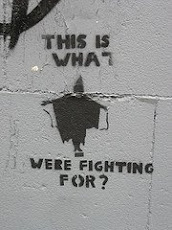Is It Right?
Originally the structure of this lesson followed a Socratic inquiry in with combinaton jigsaw reading. It has been revised with Paulo Friere's 4 step learning process drawn from his seminal work The Pedagogy of the Oppressed as articulated to our class in 'Experiential Learning and Facilitation' by lecturer Chris Jansen of The Christchurch College of Education, of the University of Canterbury, July 2009. The 4 step process is as follows:
1. Own Story - students give their own opinion on an issue
2. Expert - students examine an expert's point of view on the same issue
3. Critque - students critique the expert
4. Evaluation - students process what they have learnt from steps 1-3
The starter activity was drawn directly a lecture given by Chris Jansen, 21 July, 2009 at the Christchurch College of Education.
Socratic inquiry
Teaching usually involves simply explaining things to students. The object of a Socratic Inquiry is to ask questions of the students and have them come up collectively with the answers by themselves.
The most effective way to run Socratic inquiries is to put students into small groups of 2-4, and circulate around the groups. Give the students about five minutes to come up with a definition.
Go from group to group and listen to their definitions. Get students to make their answers coherent and clear. For example, students tend to define ethics in terms of morality. In such a case ask them what they mean by morality and how it is different from ethics. In doing this students realize that the task is much more involved than they suspected.
Don't give answers to the students but put their responses on the board. Their answers will be verified in the reading and listening comprehension exercises that follow. Students are generally surprised that their answers are close to those given by leading ethicist Margaret Somerville.
Students tend to enjoy the the fact that the concepts are not so much difficult, but that they take time to explain. This has obvious value in that it creates discussion in class, but also requires the teaching of writing definitions; one method is presented after the reading comprehension.
What is ethics? Some definitions
Somerville tells her students ethics is firstly, ' Trying not to do the wrong thing', and secondly, '[trying] to do good things for other people'.
Ethics is the systematic investigation of questions of right and wrong, good and bad (UNESCO, 2003)
Ethics, in the empiricist view, is conduct favored consistently enough throughout a society to be expressed as a code of principles (Wilson, 1997 p.267)
Morality
The term “morality” can be used either descriptively to refer to a code of conduct put forward by a society or, some other group, such as a religion, or accepted by an individual for her own behavior or normatively to refer to a code of conduct that, given specified conditions, would be put forward by all rational persons.
Bernard Gent - Standford Encyclopedia of Philosophy
Comparison of Ethics and Morality
Ethics is derived from the Greek word ethos denoting customs. Morality comes from the Latin mores also meaning customs. Although they have the same original meaning, nowadays 'morality' has a religious connotation whereas 'ethics' does not.
'Ethics' can be considered as the study of what is right and wrong and this would naturally encompass the study of 'morality'.
(philosophyblog.au.com)
2. Consider the following issues and decide whether they are right or wrong:
Make sure students to define these things before they embark on deciding whether these things are right or wrong. For example, it is necessary to discuss the meaning of marriage before deciding whether same sex marriages are right. The answers to this question are revealed in the ABC radio interview with Somerville. She opposes these kinds of marriages because inherent in the notion of marriage is the right to have children, and is concerned about the impact them.
As for discussing the issues of cloning, nuclear power and genetically modified organisms, the effectiveness of this relies on their general knowledge of the procedures and the risks. In some classes students feel they can't form an opinion owing to a lack of knowledge.
To resolve this problem you could set up a pre-class homework task in which groups of students investigate the pros and cons of one of the issues. In class they form groups with representatives from each research group and share the information of risks and benefits.
Gay/lesbian marriage
pollution
the extinction of the polar bear
nuclear power
cloning
genetically modified crops
3.Why is it hard to decide whether these things are right or wrong?
There has been a breakdown of what Somerville calls the 'shared story'. That is, in modern secular multicultural democracies no single world view dominates. Therefore, it is hard to make ethical decisions that will satisify all members of society. Somerville explains this in Extract A in the reading comprehension. You will find that most students come to this very quickly.
4. Nowadays people seem to be preoccupied with ethics, both in the sciences and in the rest of society. Why do you think this is so?
Somerville explains in Extract A in the reading comprehension that science and technology has brought us to a position where we can change the nature of humanity and destroy ourselves. There is an urgent need to restrict research for our own protection.
References
Distinction between morality and ethics -philosophyblog.au.com
Gent, B http://plato.stanford.edu/entries/morality-definition/
UNESCO(2003) COMEST -Report of the working group on the teaching of ethics. pp.29
Return to :
Is it Right? Introducing Margret Somerville
Wednesday, September 24, 2008
Subscribe to:
Post Comments (Atom)







+II+-+socialist+art+by+night+_eulen.jpg)









No comments:
Post a Comment